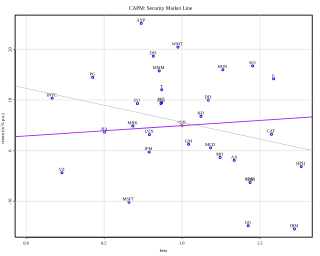In economics
Aggregate risk can be generated by a variety of sources. Fiscal, monetary, and regulatory policy can all be sources of aggregate risk. In some cases, shocks from phenomena like weather and natural disaster can pose aggregate risks. Small economies can also be subject to aggregate risks generated by international conditions such as terms of trade shocks.
Aggregate risk has potentially large implications for economic growth. For example, in the presence of credit rationing, aggregate risk can cause bank failures and hinder capital accumulation. [4] Banks may respond to increases in profitability-threatening aggregate risk by raising standards for quality and quantity credit rationing to reduce monitoring costs; but the practice of lending to small numbers of borrowers reduces the diversification of bank portfolios (concentration risk) while also denying credit to some potentially productive firms or industries. As a result, capital accumulation and the overall productivity level of the economy can decline.
In economic modeling, model outcomes depend heavily on the nature of risk. Modelers often incorporate aggregate risk through shocks to endowments (budget constraints), productivity, monetary policy, or external factors like terms of trade. Idiosyncratic risks can be introduced through mechanisms like individual labor productivity shocks; if agents possess the ability to trade assets and lack borrowing constraints, the welfare effects of idiosyncratic risks are minor. The welfare costs of aggregate risk, though, can be significant.
Under some conditions, aggregate risk can arise from the aggregation of micro shocks to individual agents. This can be the case in models with many agents and strategic complementarities; [5] situations with such characteristics include: innovation, search and trading, production in the presence of input complementarities, and information sharing. Such situations can generate aggregate data which are empirically indistinguishable from a data-generating process with aggregate shocks.
Example: Arrow–Debreu equilibrium
The following example is from Mas-Colell, Whinston, and Green (1995). [6] Consider a simple exchange economy with two identical agents, one (divisible) good, and two potential states of the world (which occur with some probability). Each agent has expected utility in the form where and are the probabilities of states 1 and 2 occurring, respectively. In state 1, agent 1 is endowed with one unit of the good while agent 2 is endowed with nothing. In state 2, agent 2 is endowed with one unit of the good while agent 1 is endowed with nothing. That is, denoting the vector of endowments in state i as we have , . Then the aggregate endowment of this economy is one good regardless of which state is realized; that is, the economy has no aggregate risk. It can be shown that, if agents are allowed to make trades, the ratio of the price of a claim on the good in state 1 to the price of a claim on the good in state 2 is equal to the ratios of their respective probabilities of occurrence (and, hence, the marginal rates of substitution of each agent are also equal to this ratio). That is, . If allowed to do so, agents make trades such that their consumption is equal in either state of the world.
Now consider an example with aggregate risk. The economy is the same as that described above except for endowments: in state 1, agent 1 is endowed two units of the good while agent 2 still receives zero units; and in state 2, agent 2 still receives one unit of the good while agent 1 receives nothing. That is, , . Now, if state 1 is realized, the aggregate endowment is 2 units; but if state 2 is realized, the aggregate endowment is only 1 unit; this economy is subject to aggregate risk. Agents cannot fully insure and guarantee the same consumption in either state. It can be shown that, in this case, the price ratio will be less than the ratio of probabilities of the two states: , so . Thus, for example, if the two states occur with equal probabilities, then . This is the well-known finance result that the contingent claim that delivers more resources in the state of low market returns has a higher price.
In heterogeneous agent models
While the inclusion of aggregate risk is common in macroeconomic models, considerable challenges arise when researchers attempt to incorporate aggregate uncertainty into models with heterogeneous agents. In this case, the entire distribution of allocational outcomes is a state variable which must be carried across periods. This gives rise to the well-known curse of dimensionality. One approach to the dilemma is to let agents ignore attributes of the aggregate distribution, justifying this assumption by referring to bounded rationality. Den Haan (2010) evaluates several algorithms which have been applied to solving the Krusell and Smith (1998) model, showing that solution accuracy can depend heavily on solution method. [7] [8] Researchers should carefully consider the results of accuracy tests while choosing solution methods and pay particular attention to grid selection.[ according to whom? ]















